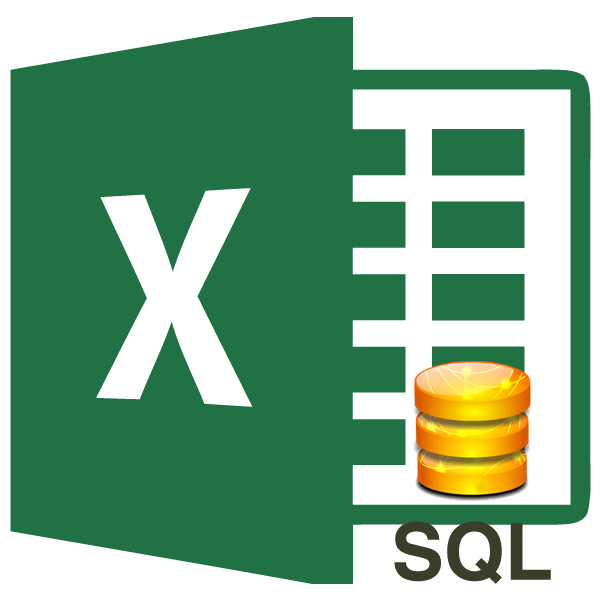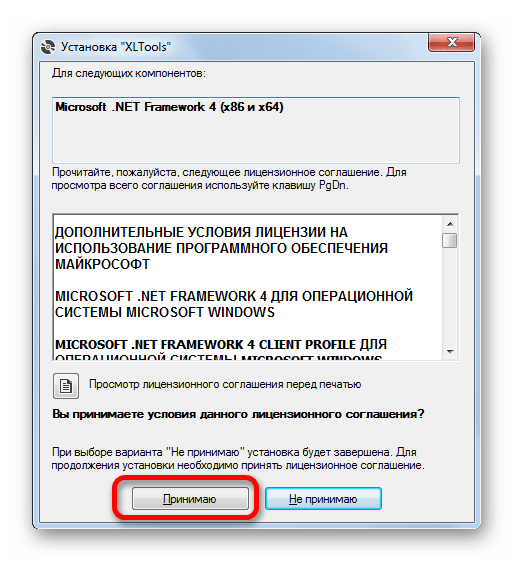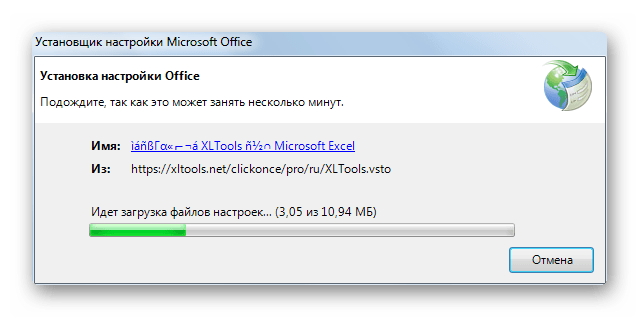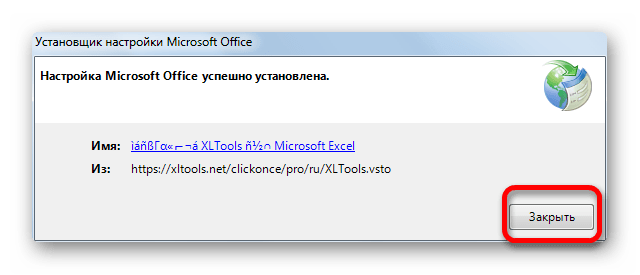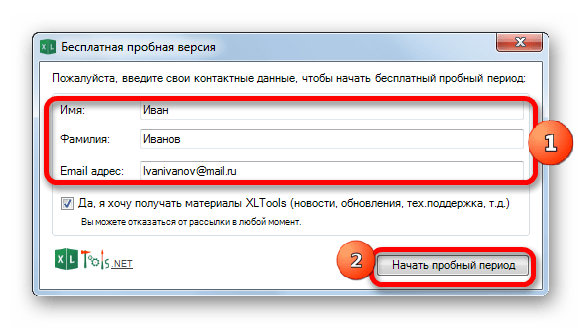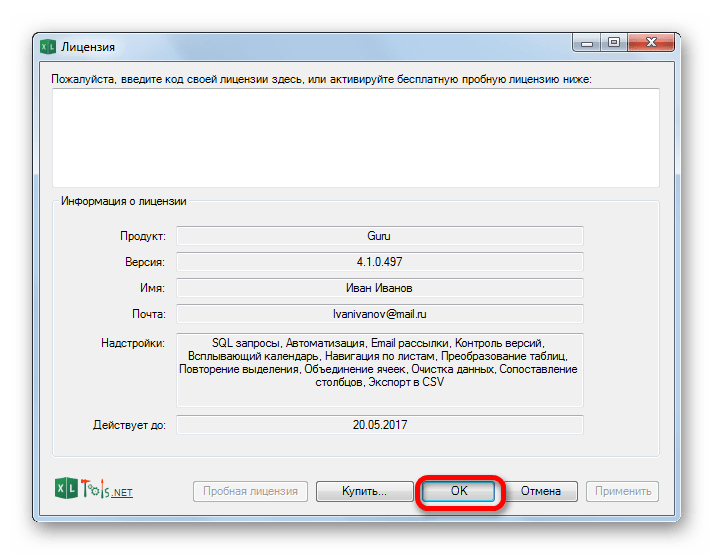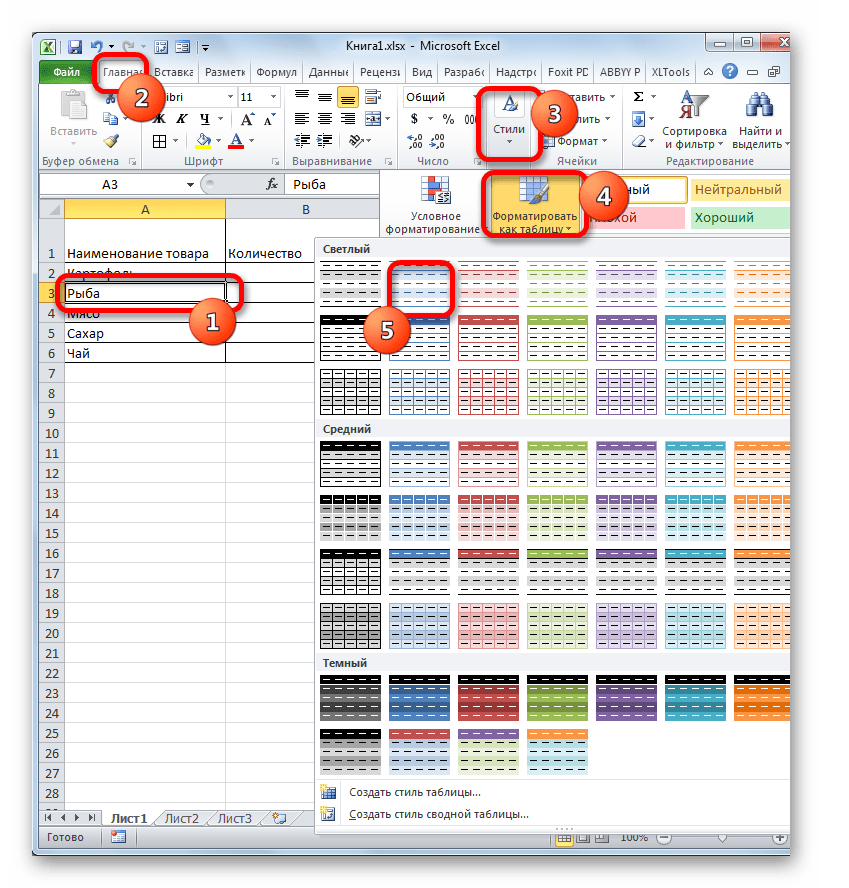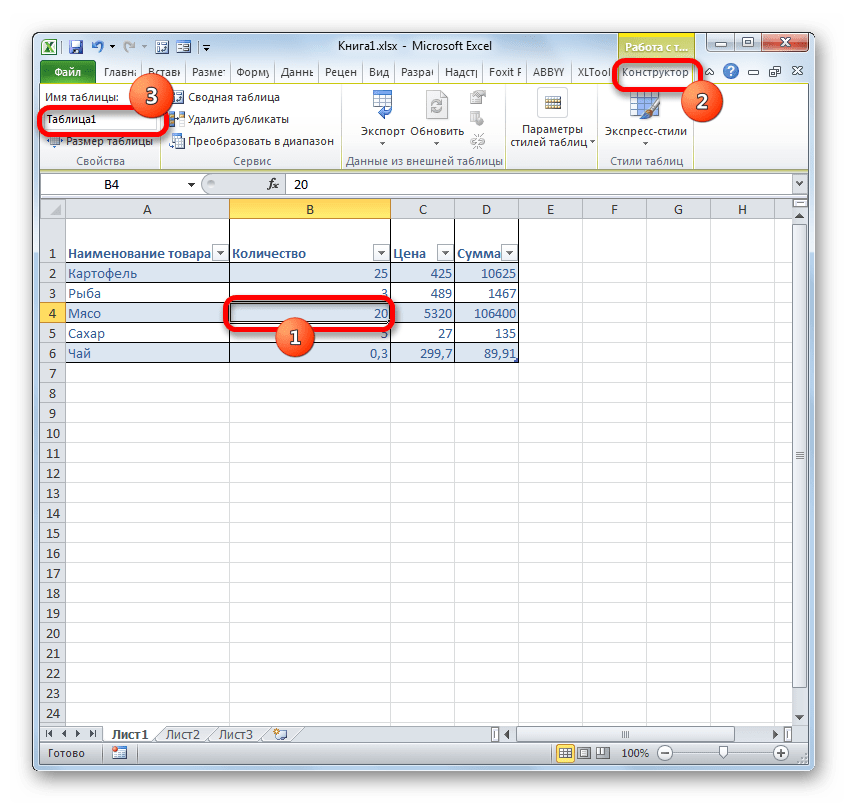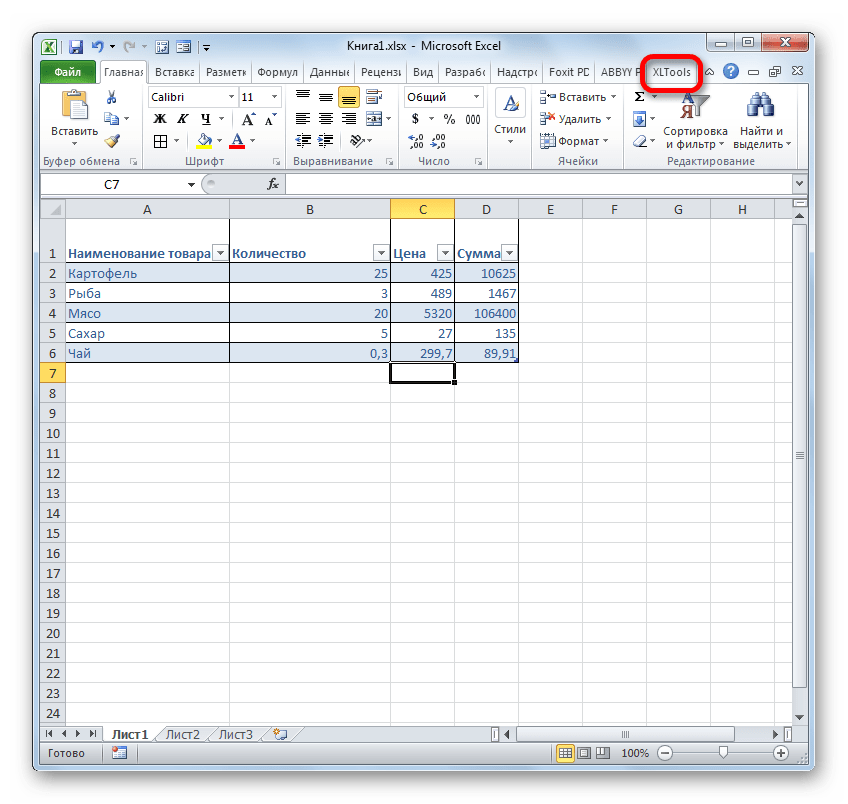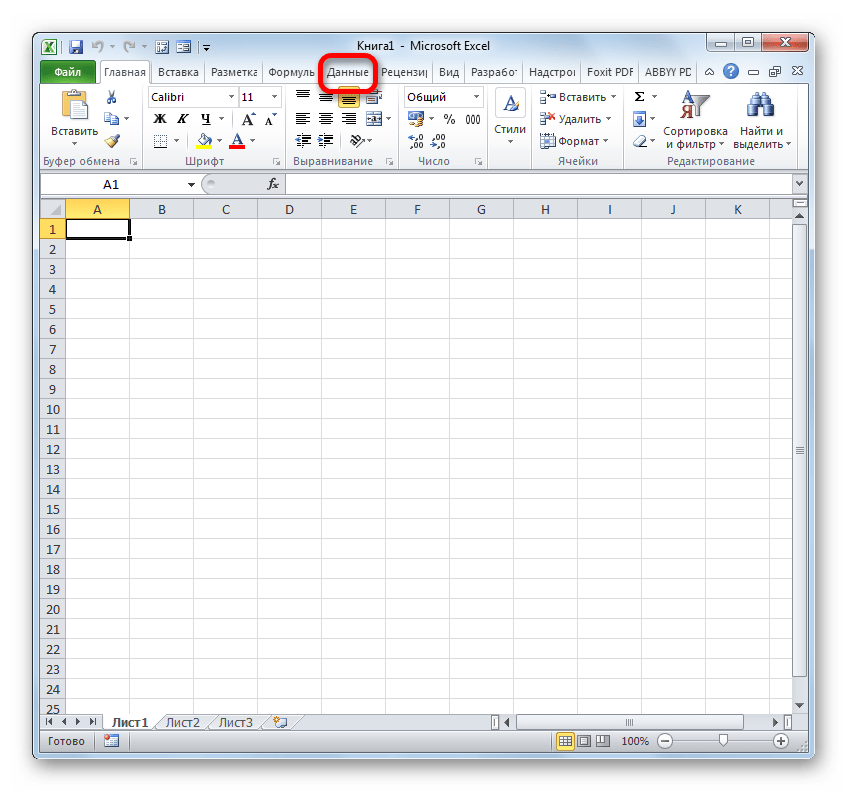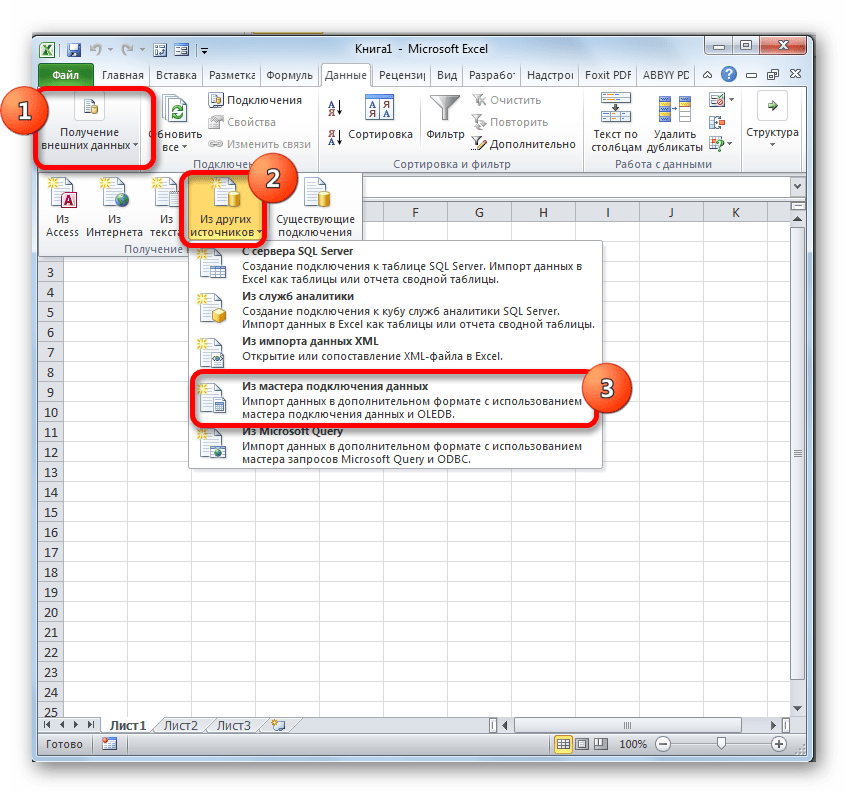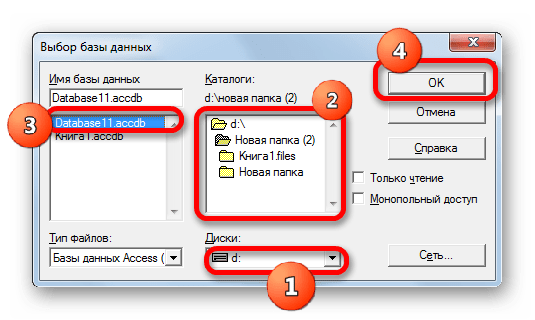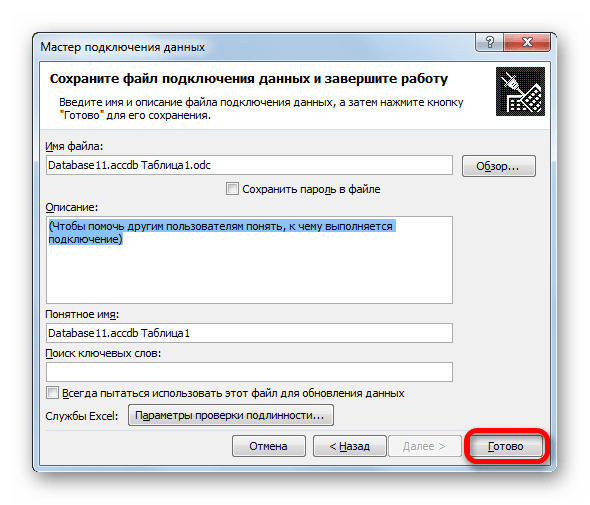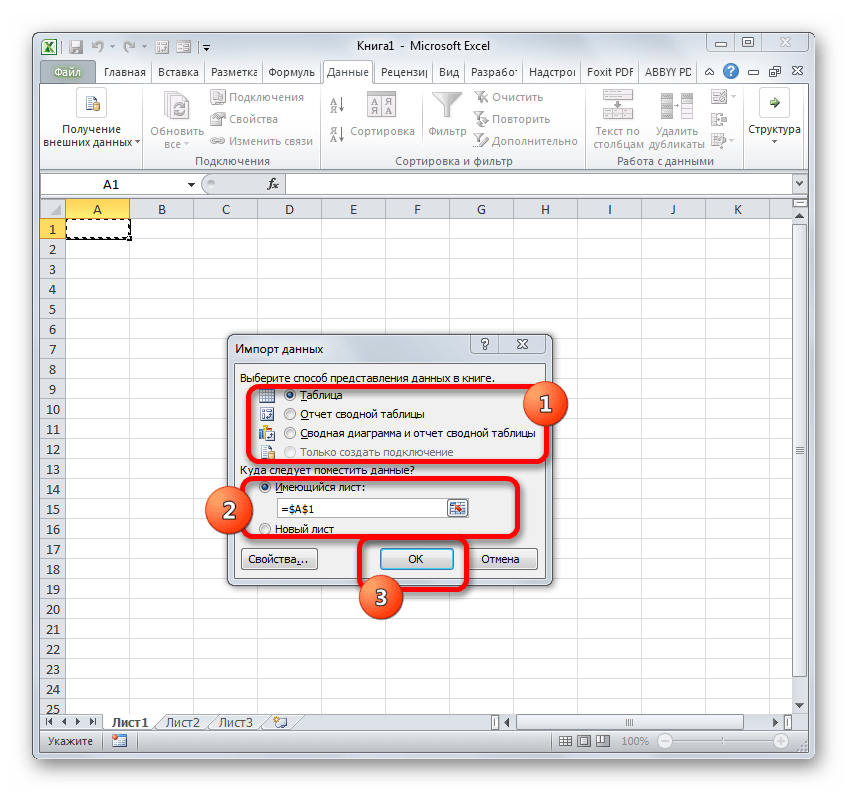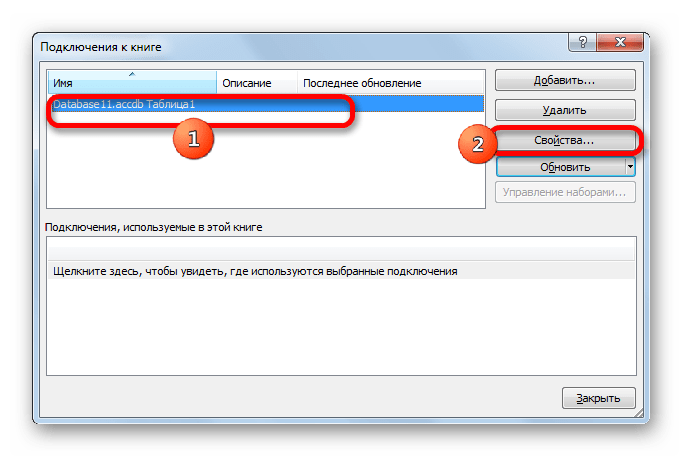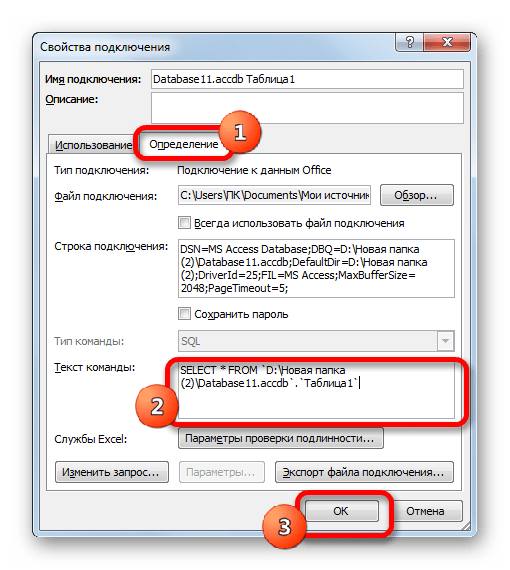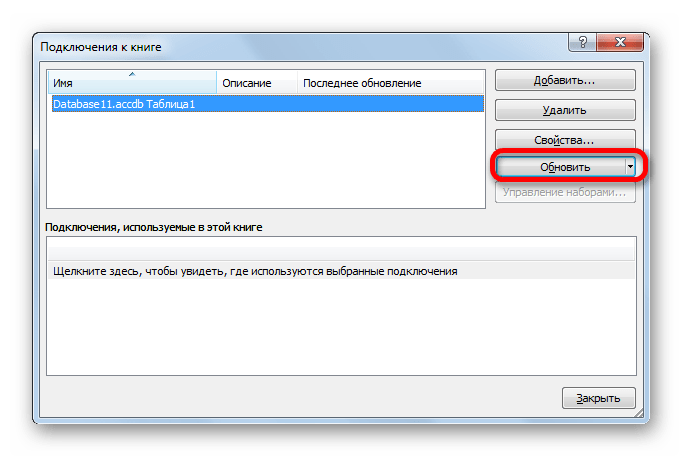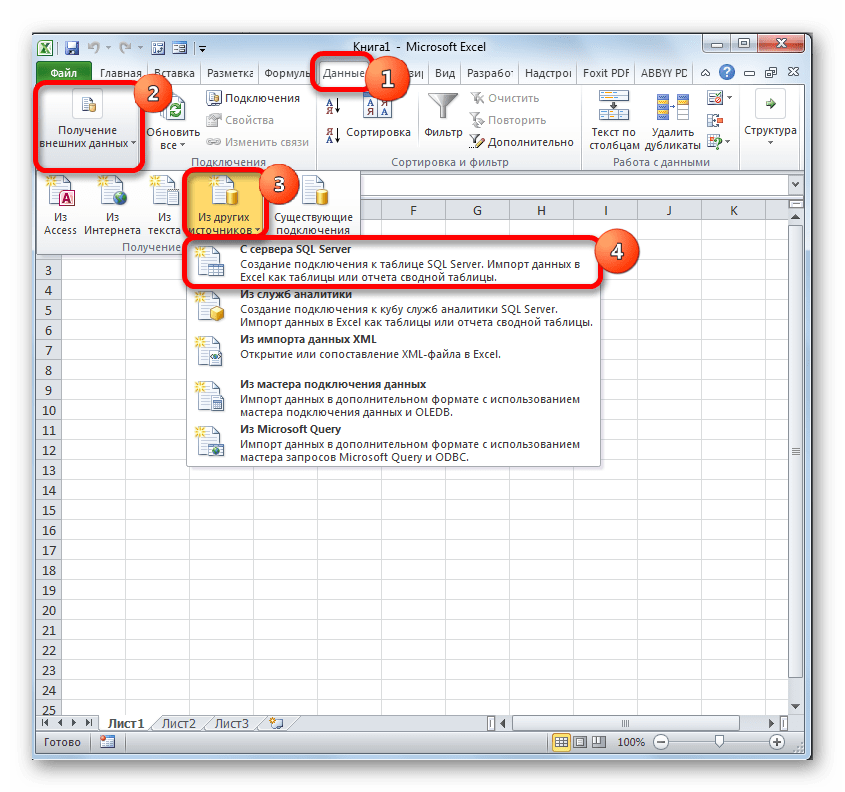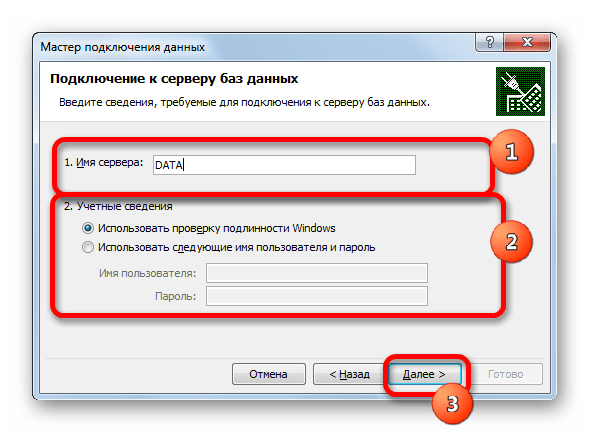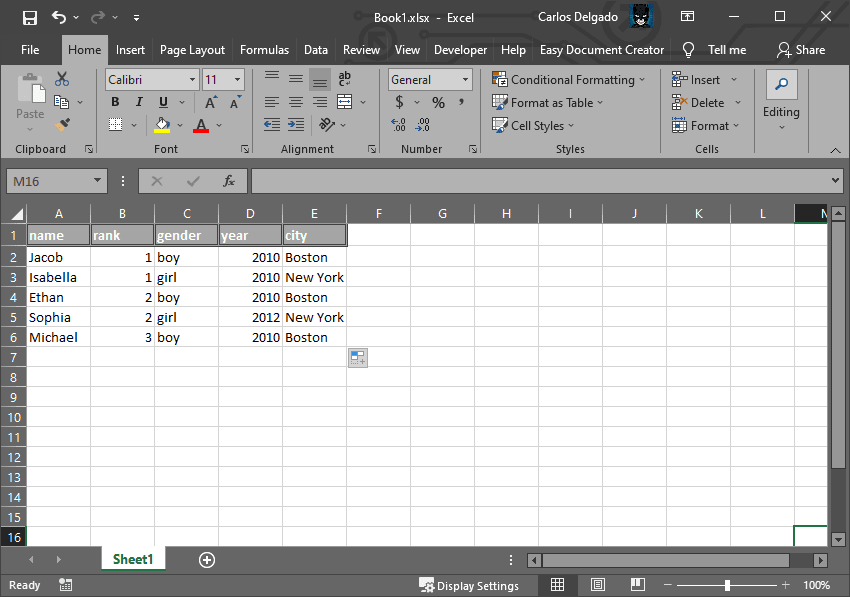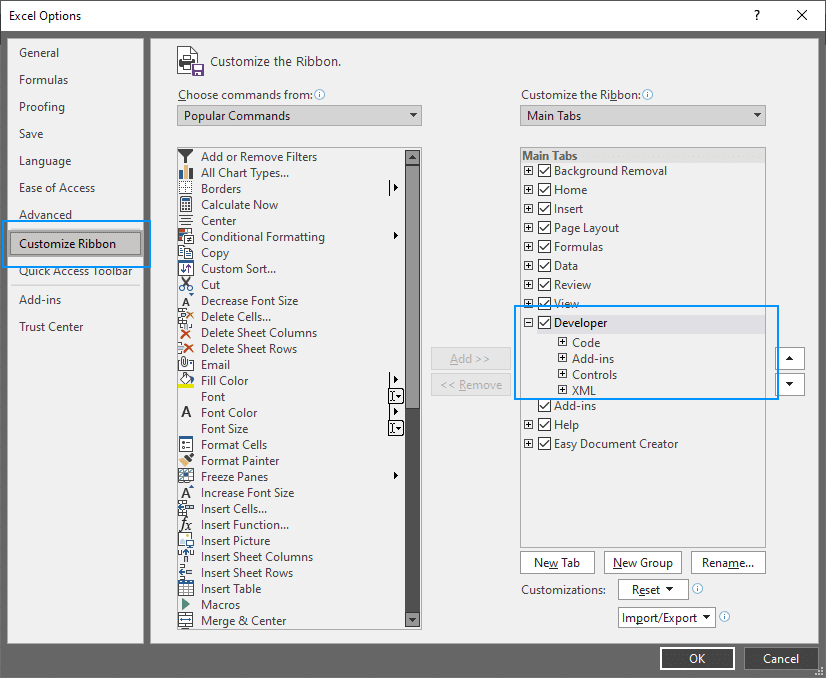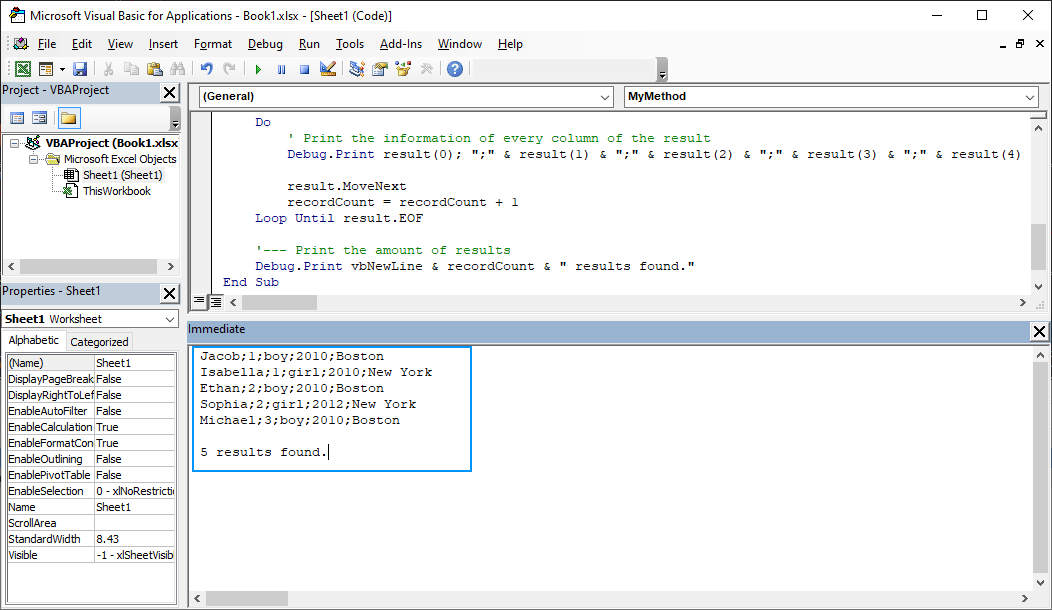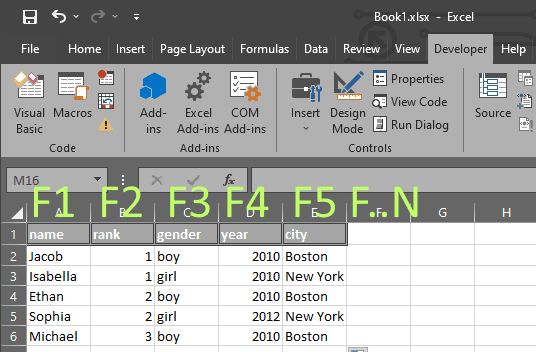There are many fine ways to get this done, which others have already suggestioned. Following along the «get Excel data via SQL track», here are some pointers.
-
Excel has the «Data Connection Wizard» which allows you to import or link from another data source or even within the very same Excel file.
-
As part of Microsoft Office (and OS’s) are two providers of interest: the old «Microsoft.Jet.OLEDB», and the latest «Microsoft.ACE.OLEDB». Look for them when setting up a connection (such as with the Data Connection Wizard).
-
Once connected to an Excel workbook, a worksheet or range is the equivalent of a table or view. The table name of a worksheet is the name of the worksheet with a dollar sign («$») appended to it, and surrounded with square brackets («[» and «]»); of a range, it is simply the name of the range. To specify an unnamed range of cells as your recordsource, append standard Excel row/column notation to the end of the sheet name in the square brackets.
-
The native SQL will (more or less be) the SQL of Microsoft Access. (In the past, it was called JET SQL; however Access SQL has evolved, and I believe JET is deprecated old tech.)
-
Example, reading a worksheet:
SELECT * FROM [Sheet1$] -
Example, reading a range:
SELECT * FROM MyRange -
Example, reading an unnamed range of cells:
SELECT * FROM [Sheet1$A1:B10] -
There are many many many books and web sites available to help you work through the particulars.
Further notes
By default, it is assumed that the first row of your Excel data source contains column headings that can be used as field names. If this is not the case, you must turn this setting off, or your first row of data «disappears» to be used as field names. This is done by adding the optional HDR= setting to the Extended Properties of the connection string. The default, which does not need to be specified, is HDR=Yes. If you do not have column headings, you need to specify HDR=No; the provider names your fields F1, F2, etc.
A caution about specifying worksheets: The provider assumes that your table of data begins with the upper-most, left-most, non-blank cell on the specified worksheet. In other words, your table of data can begin in Row 3, Column C without a problem. However, you cannot, for example, type a worksheet title above and to the left of the data in cell A1.
A caution about specifying ranges: When you specify a worksheet as your recordsource, the provider adds new records below existing records in the worksheet as space allows. When you specify a range (named or unnamed), Jet also adds new records below the existing records in the range as space allows. However, if you requery on the original range, the resulting recordset does not include the newly added records outside the range.
Data types (worth trying) for CREATE TABLE: Short, Long, Single, Double, Currency, DateTime, Bit, Byte, GUID, BigBinary, LongBinary, VarBinary, LongText, VarChar, Decimal.
Connecting to «old tech» Excel (files with the xls extention): Provider=Microsoft.Jet.OLEDB.4.0;Data Source=C:MyFolderMyWorkbook.xls;Extended Properties=Excel 8.0;. Use the Excel 5.0 source database type for Microsoft Excel 5.0 and 7.0 (95) workbooks and use the Excel 8.0 source database type for Microsoft Excel 8.0 (97), 9.0 (2000) and 10.0 (2002) workbooks.
Connecting to «latest» Excel (files with the xlsx file extension): Provider=Microsoft.ACE.OLEDB.12.0;Data Source=Excel2007file.xlsx;Extended Properties="Excel 12.0 Xml;HDR=YES;"
Treating data as text: IMEX setting treats all data as text. Provider=Microsoft.ACE.OLEDB.12.0;Data Source=Excel2007file.xlsx;Extended Properties="Excel 12.0 Xml;HDR=YES;IMEX=1";
(More details at http://www.connectionstrings.com/excel)
More information at http://msdn.microsoft.com/en-US/library/ms141683(v=sql.90).aspx, and at http://support.microsoft.com/kb/316934
Connecting to Excel via ADODB via VBA detailed at http://support.microsoft.com/kb/257819
Microsoft JET 4 details at http://support.microsoft.com/kb/275561
In Excel, you may want to load a query into another worksheet or Data Model.
- In Excel, select Data > Queries & Connections, and then select the Queries tab.
- In the list of queries, locate the query, right click the query, and then select Load To.
- Decide how you want to import the data, and then select OK.
Contents
- 1 Can you run a SQL query in Excel?
- 2 What is the query function in Excel?
- 3 How do I get data from SQL query in Excel?
- 4 How do I do a query formula in Excel?
- 5 Where do I run SQL commands?
- 6 How do you insert a query in Excel?
- 7 Which key will use to run the query?
- 8 How do you create a query?
- 9 How do I automatically import data into Excel?
- 10 How do I start a SQL query?
- 11 How do I do a SQL query?
- 12 How do you enter a query in SQL?
- 13 How does a Vlookup work?
- 14 How do you run a query in Microsoft Access?
- 15 Can we run a query without saving it?
- 16 What are the different ways to create query?
- 17 How do I turn a query into a table?
- 18 What is query give an example?
- 19 How do I pull data from another sheet in Excel?
- 20 How do I automatically extract data from a website in Excel?
Can you run a SQL query in Excel?
Using SQL statements in Excel enables you to connect to an external data source, parse field or table contents and import data – all without having to input the data manually. Once you import external data with SQL statements, you can then sort it, analyze it or perform any calculations that you might need.
What is the query function in Excel?
The Power Query Editor provides a data query and shaping experience for Excel that you can use to reshape data from many data sources. To display the Power Query Editor window, import data from external data sources in an Excel worksheet, select a cell in the data, and then select Query > Edit.
How do I get data from SQL query in Excel?
Open Microsoft Excel file and go to the Data tab on the Excel Ribbon (Under menu bar). Click “From other sources” icon in the “Get External Data” section and select “From SQL Server” on the dropdown menu. After the selection of “From SQL Server”, the Data Connection Wizard window opens.
How do I do a query formula in Excel?
Create a simple formula
In the POWER QUERY ribbon tab, choose From Other Sources > Blank Query. In the Query Editor formula bar, type = Text. Proper(“text value”), and press Enter or choose the Enter icon. Power Query shows you the results in the formula results pane.
Where do I run SQL commands?
Running a SQL Command
On the Workspace home page, click SQL Workshop and then SQL Commands. The SQL Commands page appears. Enter the SQL command you want to run in the command editor. Click Run (Ctrl+Enter) to execute the command.
How do you insert a query in Excel?
Once the data is ready it is very easy to generate the SQL queries using excel string addition operator – &. For the above tabular structure, the concatenate formula would look like: =”insert into customers values(‘” &B3 &”‘,’” & C3 & “‘,’”&D3&”‘);” where B3, C3, D3 refer to above table data.
Which key will use to run the query?
Run SQL window – shortcut keys
| Ctrl + A | select all |
|---|---|
| F2 | build column list for query table |
| F4 | select current statement |
| F5 | run SQL |
| F6 | check syntax |
How do you create a query?
On the Create tab, in the Queries group, click Query Wizard. In the New Query dialog box, click Simple Query Wizard, and then click OK. Next, you add fields. You can add up to 255 fields from as many as 32 tables or queries.
How do I automatically import data into Excel?
You can also import data into Excel as either a Table or a PivotTable report.
- Select Data > Get Data > From Database > From SQL Server Analysis Services Database (Import).
- Enter the Server name, and then select OK.
- In the Navigator pane select the database, and then select the cube or tables you want to connect.
How do I start a SQL query?
Execute a Query in SQL Server Management Studio
- Open Microsoft SQL Server Management Studio.
- Select [New Query] from the toolbar.
- Copy the ‘Example Query’ below, by clicking the [Copy Text] button.
- Select the database to run the query against, paste the ‘Example Query’ into the query window.
How do I do a SQL query?
How to Create a SQL Statement
- Start your query with the select statement. select [all | distinct]
- Add field names you want to display. field1 [,field2, 3, 4, etc.]
- Add your statement clause(s) or selection criteria. Required:
- Review your select statement. Here’s a sample statement:
How do you enter a query in SQL?
Work
- Introduction.
- 1Open your database and click the CREATE tab.
- 2Click Query Design in the Queries section.
- 3Select the POWER table.
- 4Click the Home tab and then the View icon in the left corner of the Ribbon.
- 5Click SQL View to display the SQL View Object tab.
How does a Vlookup work?
The VLOOKUP function performs a vertical lookup by searching for a value in the first column of a table and returning the value in the same row in the index_number position. The VLOOKUP function is a built-in function in Excel that is categorized as a Lookup/Reference Function.
How do you run a query in Microsoft Access?
1. How to Run a Select Query in Microsoft Access
- Open your database in Access, click the Create tab at the top, and select Query Wizard.
- Choose Simple Query Wizard and click OK.
- Select your database table from the dropdown menu.
- If you want to add all the fields, click the double-right-arrow icon.
Can we run a query without saving it?
The given statement is false. We cannot run a query without saving it.
What are the different ways to create query?
The two ways to create queries are Navigation queries and keyword search queries.
How do I turn a query into a table?
On the Design tab, in the Query Type group, click Make Table. The Make Table dialog box appears. In the Table Name box, enter a name for the new table. Click the down-arrow and select an existing table name.
What is query give an example?
Query is another word for question. In fact, outside of computing terminology, the words “query” and “question” can be used interchangeably. For example, if you need additional information from someone, you might say, “I have a query for you.” In computing, queries are also used to retrieve information.
How do I pull data from another sheet in Excel?
Type = in your cell, then click the other sheet and select the cell you want, and press enter. That’ll type the function for you. Now, if you change the data in the original B3 cell in the Names sheet, the data will update everywhere you’ve referenced that cell. Need to calculate values from that cell?
Getting web data using Excel Web Queries
- Go to Data > Get External Data > From Web.
- A browser window named “New Web Query” will appear.
- In the address bar, write the web address.
- The page will load and will show yellow icons against data/tables.
- Select the appropriate one.
- Press the Import button.
26 Sep ’22 by Antonio Nakić-Alfirević
SQL Query function in Excel
If you’re reading this article you probably know that Google Sheets has a QUERY function that allows you to run SQL-like queries against data in the sheet. This function lets you do all sorts of gymnastics with the data in your sheet, be it filtering, aggregating, or pivoting data.
Being a fully-fledged desktop app, Excel tends to be more feature-rich than Google Sheets. This is especially true in the data analytics department where Excel shines with advanced Excel functions as well as Power Query functionality.
However, Excel doesn’t natively have a QUERY function that you can use in cells on the sheet.
In this blog post, I’m going to show you how to add a QUERY function to Excel and give a few examples of how to use it.
First look
Let’s start by taking a look at the function in action.
The function is pretty straightforward. It accepts the SQL query as the first parameter and returns a table with the results of the query.
The results automatically spill to the necessary amount of space. This spilling behavior relies on the dynamic array functionality that’s available in Excel 365 (but isn’t in earlier versions of Microsoft Excel).
Works with Excel tables
In Google Sheets, the QUERY function references data by address (e.g. “A1:B10”) while columns are referenced by letters (e.g. A, B, C…).
This works but has some drawbacks:
- It makes the query sensitive to the location of the data. If the data is moved or if columns are reordered, the query will break.
- It makes the query difficult to read since it uses range addresses and column letters instead of table and column names (e.g. Employees, DateOfBirth…)
- Adding or removing rows can break the query. For example, if the provided range is “A1:H10” the query will only take into account the first 10 rows. If additional rows are added, the query will not take them into account. You can get around this by omitting the end row number (e.g. “A1:H”), but this means that there must be no other content below the data range.
Excel, on the other hand, allows explicitly defining tables (aka ListObjects) that delineate the areas that hold data. Each Excel table has a name, as do its columns. This makes Excel tables very similar to database tables and makes them easier to work with from SQL.
Full SQL syntax support (SQLite)
Under the hood, the Windy.Query function is powered by SQLite – a small but powerful embedded database engine.
When called, the function passes the query to the built-in SQLite engine which has an adapter that lets it use Excel tables as its data source.
This means that the entire SQLite syntax is available for use in queries. In comparison, in Google Sheets, the query syntax is rather limited. It only supports a single table (no joins) and a very small set of built-in functions.
Examples of use
Since the engine under the hood is SQLite, queries can use all operations available in SQLite, including table joins, temp tables, column table expressions, window functions etc… Let’s go over some examples of how to use these in Excel.
Joining tables
Here’s an example of a simple one-to-many join:
The usual way of doing a simple operation such as this one in Excel would be to use xlookup or PowerQuery, but SQL is now another option. And if we needed anything more complex than a simple join, SQL would quickly shine as the most powerful and convenient option of the three.
Merging table rows (union)
Another way we might want to combine two (or more) tables is to combine their rows. We can do this with a SQL UNION operator.
The tables might have some rows in common. If we want to keep only one instance of such rows we would use the regular UNION operator. If we want to keep both versions of rows that are in common, we would use the UNION ALL operator.
Finding differences between two tables
In the previous example, we had two tables that had some rows in common and some rows not. Let’s assume, for example, that the first table contains last year’s list of employees and the second table is the new list of employees.
If we wanted to find out the differences between the two tables, we could easily do that with a bit of SQL.
All of the rows that are in the first table but not in the second one we will mark as “deleted”. All of the rows that are in the second table but not in the first one we will mark as “added”. Here’s what that SQL query looks like:
select id, name, 'deleted' from employees e where not exists (select * from Employees_New en where e.id == en.Id) union select id, name, 'added' from employees_new en where not exists (select * from Employees e where e.id == en.Id)
And here’s what the result looks like:
Ranking rows
Another useful thing we might want to do is rank rows based on some criteria. For example, suppose we have a table with a list of cities. For each city we have its population and the country it belongs to.
Our task is to find the top 3 cities in each country based on population. Here’s how we might do that in SQL.
-- we use this CTE so we can reference the calculated 'rank_pop' column in the where clause with cte as ( select city, country, population, -- using the RANK() window function RANK() OVER (PARTITION BY country ORDER BY population) as rank_pop from cities c) select * from cte where -- filtering by the 'rank_pop' column from the CTE rank_pop <= 3 order by country, rank_pop
This query is a bit more complex than the previous ones. It uses a common table expression and a window function (the rank function), and showcases the ability to write complex SQL in queries.
Queries can also make use of dozens of built-in SQLite functions. Various specialized extended functions such as RegexReplace, GPSDist (GPS distance between two points) and LevDist (fuzzy text matching) are also available.
Updating tables
OK, this next example is a bit of a hack, but a useful one… The query you supply doesn’t need to be a SELECT query. You can do UPDATE/INSERT/DELETE statements as well, and these will modify the data in the target Excel tables.
This can be a handy way to clean and transform data in your tables in place, without having to export/import the data to an external database (e.g. SQL Server, MySql, Postgres…).
This works because the SQLite engine isn’t copying the data. Rather, it’s using an adapter that lets it access live data in the Excel table.
How does the function see Excel tables?
At first glance, it might seem strange that the query can access your workbook tables. After all, we did not pass them in as parameters, and functions normally only work with parameters that are passed to them.
However, the Windy.Query function is aware of the workbook it’s being called from and it can read data from the workbook’s tables without the need for passing them in as parameters. This makes the function much easier to call especially when working with multiple tables.
Column Headers
Results returned by the Windy.Query function can optionally include headers. This is controlled by the second parameter of the function.
The texts in the column headers are determined by the SQL query itself. You can easily rename result columns by aliasing them in the select list.
Automatically refresh results
By default, the SQL query runs as a one-off operation when you enter the formula but does not refresh if the source tables change. However, if you want the query to refresh whenever one of the source tables changes, you can easily do so by setting the autoRefresh argument to true.
Note that the auto-refresh functionality relies on Excel’s RTD (Real-Time Data) server. The RTD server usually throttles updates so functions don’t overwhelm Excel with frequent updates. The default throttle interval is 2s meaning that the function will not update more than once every 2s. To improve responsiveness, you can lower this value to something like 20ms. The simplest way to do this is through the “Configure” dialog in the QueryStorm runtime’s ribbon.
Passing parameters
When needed, SQL queries can use values from cells as parameters. To use a cell as a parameter in a query, start by giving the cell a name (named range).
Once the cell has a name, you can reference it in the query using the @paramName or $paramName syntax.
If automatic refresh is turned on, results will automatically refresh whenever one of the parameter cells changes its value.
Performance
This is all well and good for small tables, you might think, but how does it handle large data sets? Well, it handles them quite well. The function can read source tables of 100k rows and 10 columns within a few milliseconds and can return this amount of data in a second or two. In addition to this, all columns are automatically indexed so searches and joins are extremely performant as well.
This makes the function perform very well, both from the data throughput standpoint as well as from the computational one.
OK, so is this better than the Google Sheets version of the QUERY function?
Yes, dah. Did you read the previous chapters? 😛
Installing the Windy.Query function
So how do you install this function into your Excel? It’s a simple 2-step process.
Step 1 is to install the QueryStorm Runtime add-in (if you don’t already have it). This is a free, 4MB add-in for Excel that lets you install and use various extensions for Excel. It’s basically an app store for Excel.
Step 2 is to click the “Extensions” button in the “QueryStorm” tab in the Excel ribbon, find the Windy.Query package in the “Online” tab, and install it.
What happens if I share the workbook with a user who doesn’t have the function?
Nothing bad. If the other user doesn’t have the function installed, they will see the last results of the query that were returned on your machine. They just won’t be able to refresh the results.
Advanced SQL query editor
Writing SQL queries in the formula bar can get a bit unwieldy. To make queries easier to write, it’s better to use a proper editor, preferably one that offers syntax highlighting and code completion for SQL and knows about the tables in your workbook.
For this purpose, I recommend using the QueryStorm IDE. This is an advanced IDE that lets you use SQL in Excel. You can write the query in the QueryStorm code editor and then paste the query into the Windy.Query function when you’re happy with it (if needed).
The IDE does more than just allow using SQL in Excel. You can use it to create and share functions and addins for Excel. In fact the QueryStorm IDE was used to create the Windy.Query function itself.
The IDE has a free community version for individuals and small companies, while users in larger companies can make use of the free trial license. For paid licenses, check out the pricing page.
You can read more in this blog post that’s dedicated to the QueryStorm SQL IDE.
Video demonstration
For a video demonstration of the Windy.Query function, take a look the following video:
You can do a lot of powerful things with Excel, for example connecting to other data sources. In this article, we are going to look at how we can use SQL within Excel.
What is SQL?
SQL stands for “Structured Query Language.” Microsoft SQL Server is just one of the many databases that use it. In a database:
- you store data in tables
- you can run SQL queries to retrieve data.
The advantages of using a database such as Microsoft SQL Server to store your data include:
- The data is strongly typed, meaning that you cannot store a number in a date field. This makes your data instantly validated.
- It can be a central data repository for your data on multiple projects.
- Multiple people can access the same data at the same time. This reduces duplication and inconsistencies.
- It is also well-protected with built-in security within the Relational Database Management Systems. Microsoft SQL Server offers several layers of security.
For more information, please see my Udemy article “Excel vs SQL Server.”
How do you access an SQL Server? First, you need a data connection. If you are using a work SQL Server, then you will be given details of your server by your IT department. This will include:
- The Server Name: It can also take this from the Connection String if you have it.
- Authentication Method: You will use either:
- Windows Authentication, using your Windows username and password
- SQL Server Authentication, using a separate username and password
If you have Microsoft SQL Server on your own computer, then the server name could be “localhost” or “.”, and you will probably use Windows Authentication.
You can use this connection to retrieve the Microsoft SQL Server data.
There are three different places in Excel where you can load SQL data:
- In the main Excel window
- In the Get and Transform window (also known as the Power Query editor)
- In the Power Pivot window (also known as the Data Model)
We will have a look at each of these places.
Connecting SQL to the main Excel window
The main Excel window is the one you use every time you open Excel. To load data from SQL Server, go to Data – Get Data – From Database – From SQL Server Database. This has superseded previously used methods such as Microsoft Query.
You will then have to provide the Server Name.
There are four SQL Server data sources that you could query to return the results.
- You may want the data from a table. This is the raw data.
- You may want the query results from a previously created view. This results from an SQL Server data analysis.
- You may want the results from a stored procedure. This could be a more complex analysis, or one that involves parameters. For example, you may just want all sales from the state of Florida. Here, ‘Florida’ would be a parameter.
- You may want to run an ad hoc SQL query using the SELECT statement.
If you want to run a Stored Procedure or an ad hoc query, then at this stage, you will need to click on “Advanced options” and write the query in the box provided. You will also need to enter the name of the database as well.
Next, you need to provide the Authentication mode and any credentials required:
If you want to retrieve the results of a table or query, you can select the table or query. If you then click “Load,” it will be loaded into your Excel Workbook. We will look at what happens if you click “Transform Data” in the next section of this article.
Once you have made the link, it will load the data into an Excel Table. You can then use it just like other data stored in a table.
You can refresh the data whenever you want by right-hand clicking inside the table and choosing Refresh, or by going to Table Design – Refresh.
Connecting SQL to Get and Transform
The second way to connect to SQL data is by using the Get and Transform window.
This follows the same process for connecting to SQL Server as mentioned above, except that you press “Transform Data” instead of Load.
Once you have done this, then the data is in the Get and Transform window, also known as the Power Query Editor.
You can also load data directly from the Power Query Editor. To do this, go to Home – New Source.
You can then perform additional manipulations before the data transfer into Excel. For example, you might want to:
- Hide some columns or rows (by going to Home – Choose/Remove Columns)
- Add additional columns using formulas. (However, Power Query uses a language called M, which differs significantly from Excel.)
- Summarise the data using the Group By function
If you do this in Power Query, it will reduce the amount of data that goes into Excel. Power Query reduces the amount of data that it receives from SQL Server through a process called Query Folding. For example, you could retrieve all the contents of a table into Power Query, limit the number of rows to just 50, and reduce the number of columns used to just two.
This reduction will be incorporated into the SQL statement so that Excel only retrieves the needed rows and columns from SQL Server. This reduces network traffic and increases the speed of retrieving that data.
When you leave the Power Query window by going to Home – Close & Load, it would then load the data into an Excel Table as before.
However, if you go to “Home – Close & Load To…” instead, you could then:
- Use it in a Pivot Table or Chart without loading the data in Excel as a Table.
- Save it as a Connection (without loading the data into an Excel Table).
If you save it as a connection, you can use it later as the data source in any new Pivot Tables.
In “Save & Load To…”, there is a checkbox for “Add this data to the Data Model.” If you click on this, Excel will then export the data into Power Pivot, also known as the Data Model. We’ll have a look at the Data Model in the next part of this Article.
Connecting SQL to Power Pivot
The third way of connecting SQL to Excel directly is by using the Data Model, also known as Power Pivot. To open the Data Model, you need to go to Data – Manage Data Model.
Then you can import the data into Power Pivot by going to Home – Get External Data – From Database – From SQL Server. You then connect to SQL Server in a similar process as before.
Once you have imported the data, you can then create calculation columns or measures. Power Pivot uses a formula language called DAX to build formulas. DAX is an extended version of the Excel formulas.
Once you have finished, you can then create a Power Pivot Table by going to Home – PivotTable – PivotTable.
This allows you to create Pivot Tables or charts from this data.
Where to go for more information
I hope that you have enjoyed this article.
Are you interested in Power Query or Power Pivot? Then why not join me in my “Analyzing and Visualizing Data with Microsoft Excel” course, where we have a look at these topics, together with Pivot Tables.
Do you want to learn SQL statements quickly? Please have a look at my “SQL Server Essentials in an hour” course. We will look at the six principal clauses of the SQL SELECT Statement: SELECT, FROM, WHERE, GROUP BY, HAVING, and ORDER BY.
Представьте себе ситуацию, Вы получили целевую выборку из одной базы данных, но для полноты картины, как всегда, нужны дополнительные данные. Проблема может быть в том, что нужная информация хранится в другой базе данных и возможности создать на ней свою таблицу нет, подключиться используя link тоже нельзя, да и количество элементов, по которым нужно получить данные, несколько больше, чем допустимое на данном источнике. Вот и получается, что возможность написать SQL запрос и получить нужные данные есть, но написать придется не один запрос, а потом потратить время на объединение полученных данных.
Выйти из подобной ситуации поможет Excel.
Уверен, что ни для кого не секрет, что MS Excel имеет встроенный модуль VBA и надстройки, позволяющие подключаться к внешним источникам данных, то есть по сути является мощным инструментом для аналитики, а значит идеально подходит для решения подобных задач.
Для того чтобы обойти проблему, нам потребуется таблица с целевой выборкой, в которой содержатся идентификаторы, по которым можно достаточно корректно получить недостающую информацию (это может быть уникальный идентификатор, назовем его ID, или набор из данных, находящихся в разных столбцах), ПК с установленным MS Excel, и доступом к БД с недостающей информацией и, конечно, желание получить ту самую информацию.
Создаем в MS Excel книгу, на листе которой размещаем таблицу с идентификаторами, по которым будем в дальнейшем формировать запрос (если у нас есть уникальный идентификатор, для обеспечения максимальной скорости обработки таблицу лучше представить в виде одного столбца), сохраняем книгу в формате *.xlsm, после чего приступаем к созданию макроса.
Через меню «Разработчик» открываем встроенный VBA редактор и начинаем творить.
Sub job_sql() — Пусть наш макрос называется job_sql.
Пропишем переменные для подключения к БД, записи данных и запроса:
Dim cn As ADODB.Connection
Dim rs As ADODB.Recordset
Dim sql As String
Опишем параметры подключения:
sql = «Provider=SQLOLEDB.1;Integrated Security=SSPI;Persist Security Info=True;Data Source=Storoge.company.ru Storoge.»
Объявим процедуру свойства, для присвоения значения:
Set cn = New ADODB.Connection
cn.Provider = » SQLOLEDB.1″
cn.ConnectionString = sql
cn.ConnectionTimeout = 0
cn.Open
Вот теперь можно приступать непосредственно к делу.
Организуем цикл:
For i = 2 To 1000
Как вы уже поняли конечное значение i=1000 здесь только для примера, а в реальности конечное значение соответствует количеству строк в Вашей таблице. В целях унификации можно использовать автоматический способ подсчета количества строк, например, вот такую конструкцию:
Dim LastRow As Long
LastRow = ActiveSheet.UsedRange.Row — 1 + ActiveSheet.UsedRange.Rows.Count
Тогда открытие цикла будет выглядеть так:
For i = 2 To LastRow
Как я уже говорил выше MS Excel является мощным инструментом для аналитики, и возможности Excel VBA не заканчиваются на простом переборе значений или комбинаций значений. При наличии известных Вам закономерностей можно ограничить объем выгружаемой из БД информации путем добавления в макрос простых условий, например:
If Cells(i, 2) = «Ваше условие» Then
Итак, мы определились с объемом и условиями выборки, организовали подключение к БД и готовы формировать запрос. Предположим, что нам нужно получить информацию о размере ежемесячного платежа [Ежемесячный платеж] из таблицы [payments].[refinans_credit], но только по тем случаям, когда размер ежемесячного платежа больше 0
sql = «select [Ежемесячный платеж] from [PAYMENTS].[refinans_credit] » & _
«where [Ежемесячный платеж]>0 and [Номер заявки] ='» & Cells(i, 1) & «‘ «
Если значений для формирования запроса несколько, соответственно прописываем их в запросе:
«where [Ежемесячный платеж]>0 and [Номер заявки] = ‘» & Cells(i, 1) & «‘ » & _
» and [Дата платежа]='» & Cells(i, 2) & «‘»
В целях самоконтроля я обычно записываю сформированный макросом запрос, чтобы иметь возможность проверить его корректность и работоспособность, для этого добавим вот такую строчку:
Cells(i, 3) = sql
в третьем столбце записываются запросы.
Выполняем SQL запрос:
Set rs = cn.Execute(sql)
А чтобы хоть как-то наблюдать за выполнением макроса выведем изменение i в статус-бар
Application.StatusBar = «Execute script …» & i
Application.ScreenUpdating = False
Теперь нам нужно записать полученные результаты. Для этого будем использовать оператор Do While:
j = 0
Do While Not rs.EOF
For ii = 0 To rs.Fields.Count — 1
Cells(i, 4 + j + ii) = rs.Fields(0 + ii) ‘& «;»
Указываем ячейки для вставки полученных данных (4 в примере это номер столбца с которого начинаем запись результатов)
Next ii
j = j + rs.Fields.Count
s.MoveNext
Loop
rs.Close
End If
— закрываем цикл If, если вводили дополнительные условия
Next i
cn.Close
Application.StatusBar = «Готово»
End Sub
— закрываем макрос.
В дополнение хочу отметить, что данный макрос позволяет обращаться как к БД на MS SQL так и к БД Oracle, разница будет только в параметрах подключения и собственно в синтаксисе SQL запроса.
В приведенном примере для авторизации при подключении к БД используется доменная аутентификация.
А как быть если для аутентификации необходимо ввести логин и пароль? Ничего невозможного нет. Изменим часть макроса, которая отвечает за подключение к БД следующим образом:
sql = «Provider= SQLOLEDB.1;Password=********;User ID=********;Data Source= Storoge.company.ru Storoge;APP=SFM»
Но в этом случае при использовании макроса возникает риск компрометации Ваших учетных данных. Поэтому лучше программно удалять учетные данные после выполнения макроса. Разместим поля для ввода пароля и логина на листе и изменим макрос следующим образом:
sql = «Provider= SQLOLEDB.1;Password=» & Sheets(«Лист аутентификации»).TextBox1.Value & «;User ID=» & Sheets(«Лист аутентификации «).TextBox2.Value & «;Data Source= Storoge.company.ru Storoge;APP=SFM»
Место для расположения текстовых полей не принципиально, можно расположить их на листе с таблицей в первых строках, но мне удобней размещать поля на отдельном листе. Чтобы введенные учетные данные не сохранялись вместе с результатом выполнения макроса в конце исполняемого кода дописываем:
Sheets(«Выгрузка»).TextBox1.Value = «« Sheets(»Выгрузка«).TextBox2.Value = »»
То есть просто присваиваем текстовым полям пустые значения, таким образом после выполнения макроса поля для ввода пароля и логина окажутся пустыми.
Вот такое вполне жизнеспособное решение, позволяющее сократить трудозатраты при получении и обработке данных, я использую. Надеюсь мой опыт применения SQL запросов в Excel будет полезен и вам в решении текущих задач.
Содержание
- Создание SQL запроса в Excel
- Способ 1: использование надстройки
- Способ 2: использование встроенных инструментов Excel
- Способ 3: подключение к серверу SQL Server
- Вопросы и ответы
SQL – популярный язык программирования, который применяется при работе с базами данных (БД). Хотя для операций с базами данных в пакете Microsoft Office имеется отдельное приложение — Access, но программа Excel тоже может работать с БД, делая SQL запросы. Давайте узнаем, как различными способами можно сформировать подобный запрос.
Читайте также: Как создать базу данных в Экселе
Язык запросов SQL отличается от аналогов тем, что с ним работают практически все современные системы управления БД. Поэтому вовсе не удивительно, что такой продвинутый табличный процессор, как Эксель, обладающий многими дополнительными функциями, тоже умеет работать с этим языком. Пользователи, владеющие языком SQL, используя Excel, могут упорядочить множество различных разрозненных табличных данных.
Способ 1: использование надстройки
Но для начала давайте рассмотрим вариант, когда из Экселя можно создать SQL запрос не с помощью стандартного инструментария, а воспользовавшись сторонней надстройкой. Одной из лучших надстроек, выполняющих эту задачу, является комплекс инструментов XLTools, который кроме указанной возможности, предоставляет массу других функций. Правда, нужно заметить, что бесплатный период пользования инструментом составляет всего 14 дней, а потом придется покупать лицензию.
Скачать надстройку XLTools
- После того, как вы скачали файл надстройки xltools.exe, следует приступить к его установке. Для запуска инсталлятора нужно произвести двойной щелчок левой кнопки мыши по установочному файлу. После этого запустится окно, в котором нужно будет подтвердить согласие с лицензионным соглашением на использование продукции компании Microsoft — NET Framework 4. Для этого всего лишь нужно кликнуть по кнопке «Принимаю» внизу окошка.
- После этого установщик производит загрузку обязательных файлов и начинает процесс их установки.
- Далее откроется окно, в котором вы должны подтвердить свое согласие на установку этой надстройки. Для этого нужно щелкнуть по кнопке «Установить».
- Затем начинается процедура установки непосредственно самой надстройки.
- После её завершения откроется окно, в котором будет сообщаться, что инсталляция успешно выполнена. В указанном окне достаточно нажать на кнопку «Закрыть».
- Надстройка установлена и теперь можно запускать файл Excel, в котором нужно организовать SQL запрос. Вместе с листом Эксель открывается окно для ввода кода лицензии XLTools. Если у вас имеется код, то нужно ввести его в соответствующее поле и нажать на кнопку «OK». Если вы желаете использовать бесплатную версию на 14 дней, то следует просто нажать на кнопку «Пробная лицензия».
- При выборе пробной лицензии открывается ещё одно небольшое окошко, где нужно указать своё имя и фамилию (можно псевдоним) и электронную почту. После этого жмите на кнопку «Начать пробный период».
- Далее мы возвращаемся к окну лицензии. Как видим, введенные вами значения уже отображаются. Теперь нужно просто нажать на кнопку «OK».
- После того, как вы проделаете вышеуказанные манипуляции, в вашем экземпляре Эксель появится новая вкладка – «XLTools». Но не спешим переходить в неё. Прежде, чем создавать запрос, нужно преобразовать табличный массив, с которым мы будем работать, в так называемую, «умную» таблицу и присвоить ей имя.
Для этого выделяем указанный массив или любой его элемент. Находясь во вкладке «Главная» щелкаем по значку «Форматировать как таблицу». Он размещен на ленте в блоке инструментов «Стили». После этого открывается список выбора различных стилей. Выбираем тот стиль, который вы считаете нужным. На функциональность таблицы указанный выбор никак не повлияет, так что основывайте свой выбор исключительно на основе предпочтений визуального отображения. - Вслед за этим запускается небольшое окошко. В нем указываются координаты таблицы. Как правило, программа сама «подхватывает» полный адрес массива, даже если вы выделили только одну ячейку в нем. Но на всякий случай не мешает проверить ту информацию, которая находится в поле «Укажите расположение данных таблицы». Также нужно обратить внимание, чтобы около пункта «Таблица с заголовками», стояла галочка, если заголовки в вашем массиве действительно присутствуют. Затем жмите на кнопку «OK».
- После этого весь указанный диапазон будет отформатирован, как таблица, что повлияет как на его свойства (например, растягивание), так и на визуальное отображение. Указанной таблице будет присвоено имя. Чтобы его узнать и по желанию изменить, клацаем по любому элементу массива. На ленте появляется дополнительная группа вкладок – «Работа с таблицами». Перемещаемся во вкладку «Конструктор», размещенную в ней. На ленте в блоке инструментов «Свойства» в поле «Имя таблицы» будет указано наименование массива, которое ему присвоила программа автоматически.
- При желании это наименование пользователь может изменить на более информативное, просто вписав в поле с клавиатуры желаемый вариант и нажав на клавишу Enter.
- После этого таблица готова и можно переходить непосредственно к организации запроса. Перемещаемся во вкладку «XLTools».
- После перехода на ленте в блоке инструментов «SQL запросы» щелкаем по значку «Выполнить SQL».
- Запускается окно выполнения SQL запроса. В левой его области следует указать лист документа и таблицу на древе данных, к которой будет формироваться запрос.
В правой области окна, которая занимает его большую часть, располагается сам редактор SQL запросов. В нем нужно писать программный код. Наименования столбцов выбранной таблицы там уже будут отображаться автоматически. Выбор столбцов для обработки производится с помощью команды SELECT. Нужно оставить в перечне только те колонки, которые вы желаете, чтобы указанная команда обрабатывала.
Далее пишется текст команды, которую вы хотите применить к выбранным объектам. Команды составляются при помощи специальных операторов. Вот основные операторы SQL:
- ORDER BY – сортировка значений;
- JOIN – объединение таблиц;
- GROUP BY – группировка значений;
- SUM – суммирование значений;
- DISTINCT – удаление дубликатов.
Кроме того, в построении запроса можно использовать операторы MAX, MIN, AVG, COUNT, LEFT и др.
В нижней части окна следует указать, куда именно будет выводиться результат обработки. Это может быть новый лист книги (по умолчанию) или определенный диапазон на текущем листе. В последнем случае нужно переставить переключатель в соответствующую позицию и указать координаты этого диапазона.
После того, как запрос составлен и соответствующие настройки произведены, жмем на кнопку «Выполнить» в нижней части окна. После этого введенная операция будет произведена.
Урок: «Умные» таблицы в Экселе
Способ 2: использование встроенных инструментов Excel
Существует также способ создать SQL запрос к выбранному источнику данных с помощью встроенных инструментов Эксель.
- Запускаем программу Excel. После этого перемещаемся во вкладку «Данные».
- В блоке инструментов «Получение внешних данных», который расположен на ленте, жмем на значок «Из других источников». Открывается список дальнейших вариантов действий. Выбираем в нем пункт «Из мастера подключения данных».
- Запускается Мастер подключения данных. В перечне типов источников данных выбираем «ODBC DSN». После этого щелкаем по кнопке «Далее».
- Открывается окно Мастера подключения данных, в котором нужно выбрать тип источника. Выбираем наименование «MS Access Database». Затем щелкаем по кнопке «Далее».
- Открывается небольшое окошко навигации, в котором следует перейти в директорию расположения базы данных в формате mdb или accdb и выбрать нужный файл БД. Навигация между логическими дисками при этом производится в специальном поле «Диски». Между каталогами производится переход в центральной области окна под названием «Каталоги». В левой области окна отображаются файлы, расположенные в текущем каталоге, если они имеют расширение mdb или accdb. Именно в этой области нужно выбрать наименование файла, после чего кликнуть на кнопку «OK».
- Вслед за этим запускается окно выбора таблицы в указанной базе данных. В центральной области следует выбрать наименование нужной таблицы (если их несколько), а потом нажать на кнопку «Далее».
- После этого открывается окно сохранения файла подключения данных. Тут указаны основные сведения о подключении, которое мы настроили. В данном окне достаточно нажать на кнопку «Готово».
- На листе Excel запускается окошко импорта данных. В нем можно указать, в каком именно виде вы хотите, чтобы данные были представлены:
- Таблица;
- Отчёт сводной таблицы;
- Сводная диаграмма.
Выбираем нужный вариант. Чуть ниже требуется указать, куда именно следует поместить данные: на новый лист или на текущем листе. В последнем случае предоставляется также возможность выбора координат размещения. По умолчанию данные размещаются на текущем листе. Левый верхний угол импортируемого объекта размещается в ячейке A1.
После того, как все настройки импорта указаны, жмем на кнопку «OK».
- Как видим, таблица из базы данных перемещена на лист. Затем перемещаемся во вкладку «Данные» и щелкаем по кнопке «Подключения», которая размещена на ленте в блоке инструментов с одноименным названием.
- После этого запускается окно подключения к книге. В нем мы видим наименование ранее подключенной нами базы данных. Если подключенных БД несколько, то выбираем нужную и выделяем её. После этого щелкаем по кнопке «Свойства…» в правой части окна.
- Запускается окно свойств подключения. Перемещаемся в нем во вкладку «Определение». В поле «Текст команды», находящееся внизу текущего окна, записываем SQL команду в соответствии с синтаксисом данного языка, о котором мы вкратце говорили при рассмотрении Способа 1. Затем жмем на кнопку «OK».
- После этого производится автоматический возврат к окну подключения к книге. Нам остается только кликнуть по кнопке «Обновить» в нем. Происходит обращение к базе данных с запросом, после чего БД возвращает результаты его обработки назад на лист Excel, в ранее перенесенную нами таблицу.
Способ 3: подключение к серверу SQL Server
Кроме того, посредством инструментов Excel существует возможность соединения с сервером SQL Server и посыла к нему запросов. Построение запроса не отличается от предыдущего варианта, но прежде всего, нужно установить само подключение. Посмотрим, как это сделать.
- Запускаем программу Excel и переходим во вкладку «Данные». После этого щелкаем по кнопке «Из других источников», которая размещается на ленте в блоке инструментов «Получение внешних данных». На этот раз из раскрывшегося списка выбираем вариант «С сервера SQL Server».
- Происходит открытие окна подключения к серверу баз данных. В поле «Имя сервера» указываем наименование того сервера, к которому выполняем подключение. В группе параметров «Учетные сведения» нужно определиться, как именно будет происходить подключение: с использованием проверки подлинности Windows или путем введения имени пользователя и пароля. Выставляем переключатель согласно принятому решению. Если вы выбрали второй вариант, то кроме того в соответствующие поля придется ввести имя пользователя и пароль. После того, как все настройки проведены, жмем на кнопку «Далее». После выполнения этого действия происходит подключение к указанному серверу. Дальнейшие действия по организации запроса к базе данных аналогичны тем, которые мы описывали в предыдущем способе.
Как видим, в Экселе SQL запрос можно организовать, как встроенными инструментами программы, так и при помощи сторонних надстроек. Каждый пользователь может выбрать тот вариант, который удобнее для него и является более подходящим для решения конкретно поставленной задачи. Хотя, возможности надстройки XLTools, в целом, все-таки несколько более продвинутые, чем у встроенных инструментов Excel. Главный же недостаток XLTools заключается в том, что срок бесплатного пользования надстройкой ограничен всего двумя календарными неделями.
Еще статьи по данной теме:
Помогла ли Вам статья?
Learn how to easily run a plain SQL query with Visual Basic for Applications on your Excel Spreadsheet.
In the last days, I received an unusual request from a friend that is working on something curious because of an assignment of the University. For this assignment, it’s necessary to find the answer or data as response of a query. Instead of a database, we are going to query plain data from an excel spreadsheet (yeah, just as it sounds). For example, for this article, we are going to use the following Sheet in Excel Plus 2016:
The goal of this task is to write raw SQL Queries against the available data in the spreadsheet to find the answer of the following questions:
- Which users live in Boston.
- Which users are boys and live in Boston.
- Which users were born in 2012.
- Which users were born in 2010 and were ranked in place #1.
Of course, finding such information as a regular user is quite easy and simple using filters and so, however the assignment requires to do the queries using SQL and Visual Basic for the job. In this article, I will explain you from scratch how to use Microsoft Visual Basic for Applications to develop your own macros and run some SQL queries against plain data in your excel spreadsheets.
1. Launch Microsoft Visual Basic For Applications
In order to launch the window of Visual Basic to run some code on your spreadsheets, you will need to enable the Developer tab on the excel Ribbon. You can do this easily opening the Excel options (File > Options) and searching for the Customize Ribbon tab, in this Tab you need to check the Developer checkbox to enable it in your regular interface:
Click on Ok and now you should be able to find the Developer tab on your excel ribbon. In this tab, launch the Visual Basic window:
In this new interface you will be able to run your VB code.
2. Building connection
In the Visual Basic window, open the code window of your sheet and let’s type some code! According to your needs you may create a custom macro and assign them to the action of buttons or other kind of stuff. In this example, we are going to work with plain code and will run them independently to test them. You need to understand how to connect to the workbook data source that will be handled with the following code:
Dim connection As Object
'--- Connect to the current datasource of the Excel file
Set connection = CreateObject("ADODB.Connection")
With connection
.Provider = "Microsoft.ACE.OLEDB.12.0"
.ConnectionString = "Data Source=" & ThisWorkbook.Path & "" & ThisWorkbook.Name & ";" & _
"Extended Properties=""Excel 12.0 Xml;HDR=NO"";"
.Open
End WithThe connection properties are described as follows:
- Provider: we will use the Microsoft Access Database Engine 2010 (Microsoft.ACE.OLEDB.12.0)
- ConnectionString: we will use the current excel file as the database.
HDR=Yes;: indicates that the first row contains the column names, not data.HDR=No;indicates the opposite.
You will use this connection to run the SQL.
3. Printing whole table data
The following example, will use the mentioned logic to connect to the current spreadsheet and will query the range A1:E6 (selecting the whole table in the example excel) and will print every row in the immediate window:
Sub MyMethod()
'--- Declare Variables to store the connection, the result and the SQL query
Dim connection As Object, result As Object, sql As String, recordCount As Integer
'--- Connect to the current datasource of the Excel file
Set connection = CreateObject("ADODB.Connection")
With connection
.Provider = "Microsoft.ACE.OLEDB.12.0"
.ConnectionString = "Data Source=" & ThisWorkbook.Path & "" & ThisWorkbook.Name & ";" & _
"Extended Properties=""Excel 12.0 Xml;HDR=YES"";"
.Open
End With
'--- Write the SQL Query. In this case, we are going to select manually the data range
'--- To print the whole information of the table
sql = "SELECT * FROM [Sheet1$A1:E6]"
'--- Run the SQL query
Set result = connection.Execute(sql)
'--- Fetch information
Do
' Print the information of every column of the result
Debug.Print result(0); ";" & result(1) & ";" & result(2) & ";" & result(3) & ";" & result(4)
result.MoveNext
recordCount = recordCount + 1
Loop Until result.EOF
'--- Print the amount of results
Debug.Print vbNewLine & recordCount & " results found."
End SubNote that we are using HDR so the query will use the first row of data as the column headers, so the result will be the following one:
4. Query by columns
Now that you are able to connect to the worksheet, you may now customize the SQL to fit your needs. It is necessary to explain you the most basic thing you need to know about querying some data in your excel file. The range needs to specify the Sheet Name and the regular excel range (e.g. A1:Z1) and the whole data should be selected, not individual columns. You may filter by individual columns using regular SQL statements as WHERE, AND, OR, etc.
Depending if you use HDR (first row contains the column names), the query syntax will change:
HDR=YES
If you have HDR enabled (in the extended properties of the connection), you may query through the column name, considering that you selected the appropriate range:
SELECT * FROM [Sheet1$A1:E6] WHERE [city] = 'Boston'HDR=NO
If you don’t use HDR, the nomenclature of the columns will follow the F1, F2, F3, …, FN pattern:
The following query would work perfectly if you don’t have HDR enabled (note that the range changes):
SELECT * FROM [Sheet1$A2:E6] WHERE [F5] = 'Boston'In both cases, the output will be the same in the immediate window:
Jacob;1;boy;2010;Boston
Ethan;2;boy;2010;Boston
Michael;3;boy;2010;Boston
3 results found.5. Answering questions
The SQL that should solve the initial questions will be the following ones (with HDR disabled):
Which users live in Boston.
SELECT * FROM [Sheet1$A2:E6] WHERE [F5] = 'Boston'Which users are boys and live in Boston.
SELECT * FROM [Sheet1$A2:E6] WHERE [F5] = 'Boston' and [F3] = 'boy'Which users were born in 2012.
SELECT * FROM [Sheet1$A2:E6] WHERE [F4] = 2012Which users were born in 2010 and were ranked in place #1.
SELECT * FROM [Sheet1$A2:E6] WHERE [F2] = 1 AND [F4] = 2010Happy coding ❤️!

















